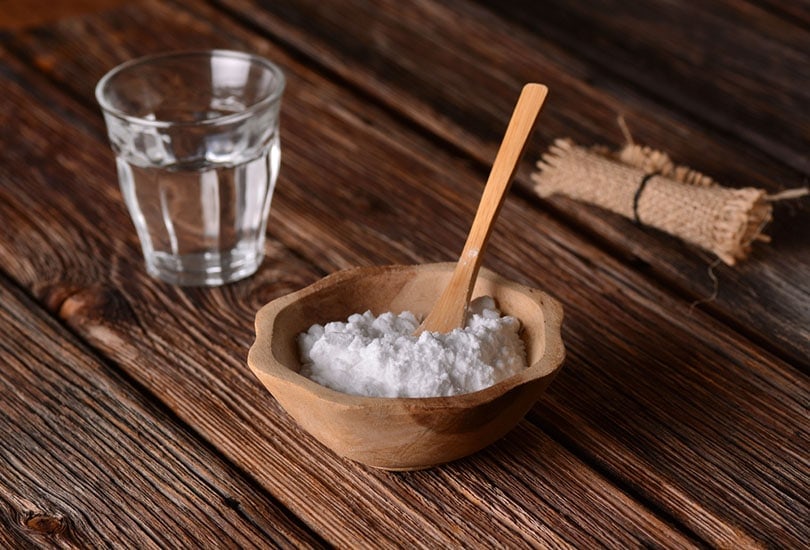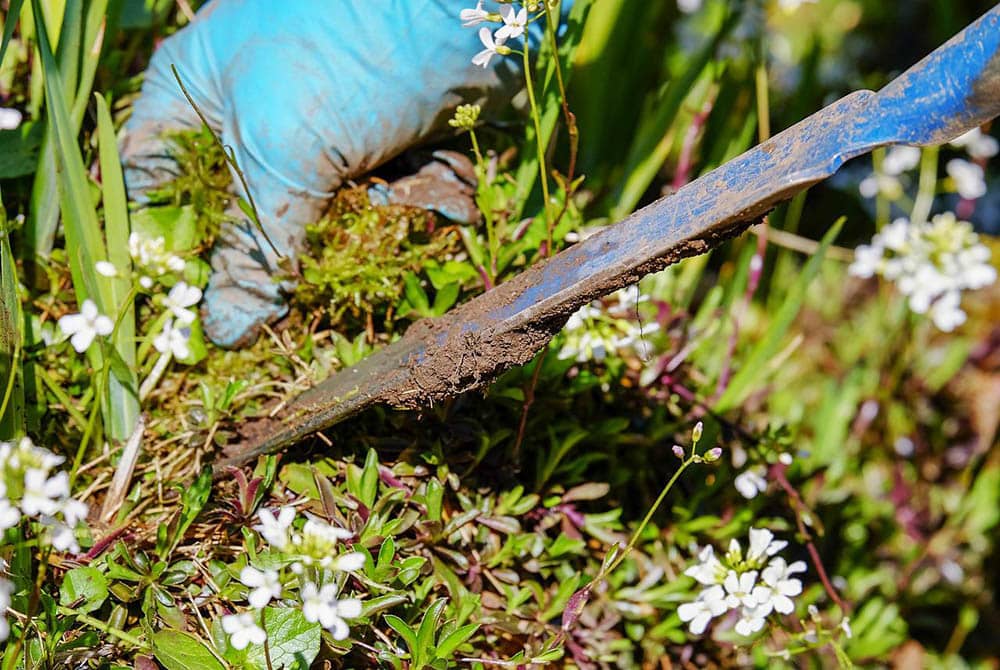Does Baking Soda Kill Weeds? Steps, Facts & FAQ
-
Kristin Hitchcock
- Last updated:

Baking soda is a natural herbicide that can kill weeds and other plants. This substance works by increasing the salt content in the soil. When exposed to high levels of salt, very few plants can survive (and these usually live in marshes by the sea shoreline). However, this method targets all plants in the area. Therefore, it is non-specific and not suitable for use unless you’re trying to kill everything. Using baking soda may not be effective for extended periods in areas with heavy rainfall. The rain will wash the salt out of the soil, allowing weeds to grow once more.
Using baking soda is quite easy, though. It is a suitable choice for driveways and sidewalks, where you don’t want any plants poking through the cracks. Plus, it’s one of the cheapest options out there. For this reason, we can recommend it in some situations, especially if you live in a drier climate where the salt will stick around for longer.
How Does Baking Soda Work?
Baking soda works in a few different ways. Firstly, if you apply it to the leaves and stem of the plant, it sucks out all the plant’s water. This process causes the plant to dry up quickly, allowing you to pull the plant out. While it doesn’t actually damage the roots, it will kill the whole plant by depriving it of water.
Baking soda works best on hot days when the pores of the plant are more open, allowing for more effective water transfer. Therefore, we recommend primarily leaving this substance on troublesome plants in the summer, though it will work during other periods, too.
This substance also affects the salt levels of the soil. Many plants cannot grow in very salty places. Therefore, it can kill plants by “poisoning” the soil they grow in and prevent them from returning. However, this salt does not last forever. When it rains, the water will wash the salt out of the soil. Therefore, baking soda’s staying power depends on the amount of rain you get.
In situations where you’re looking to kill weeds and not surrounding plants, you should apply baking soda a day or so before it rains. This allows it to kill the weed by drying out the foliage, but it won’t raise the salt levels of the soil high enough to damage surrounding plants.
Of course, this isn’t an exact science. Some plants are more sensitive to salt than others and will die even if the salt in the soil becomes slightly raised. Rain can also be difficult to predict, which makes this a bit of a hit-or-miss method.

The 5 Steps for Using Baking Soda to Kill Weeds
Getting rid of weeds with baking soda is pretty easy. This method is very safe for the environment, as the salt becomes diluted when it rains. However, it does not always work well on established weeds.
Here are our recommended instructions for using this chemical to kill weeds in your garden or yard.
1. Create a Baking Soda Solution
First, you’ll need to create a solution with baking soda. To do this, simply mix a tablespoon of baking soda into a cup of water or vinegar. Vinegar is another strong herbicide, so it works well against weeds. However, it can also damage other plants. Therefore, if you’re close to beneficial plants, you may want to use water instead.
Put the solution into a spray bottle to make application easy.

2. Soak the Weed
Simply spray the solution on the weed. If you’re using water, you’ll need more than if you’re using vinegar. You want the salt to coat the plant and draw out the water as the solution dries. The solution will dry fastest in the sun, so plan to apply it around lunch. Don’t apply it on a day it is going to rain, as this will simply wash the baking soda off of the plant.
However, if you’re looking to kill weeds before replanting, then you do want it to rain between application and planting. Keep this in mind while you’re planning. Sometimes, it is best to apply the application only a few days before it rains so that nature will do the cleanup job for you.
If you’re looking to prevent plants from growing in the area, apply a decent amount to the surrounding soil, as well. Of course, baking soda does not work well as a preventative in wetter areas.
3. Remove the Weeds
The baking soda will dry the weeds up and cause them to turn brown but you will still need to remove them. Luckily, you don’t typically have to worry about them growing back since a lack of water should kill the roots, as well.
However, this is where mature weeds have an upper hand. Sometimes, the root system is so large that baking soda only kills the top part of the plant. Prepare to re-apply the solution if the plant was larger.

4. Replant the Area
Next, you can add plant seeds if applicable. The baking soda will leave the soil after the first good rain, so replant directly afterward. You don’t want seeds setting up shop before your plants. You can also rinse the soil well before planting if it does not rain commonly in your area, but rain tends to be more effective.
5. Repeat as Needed
Baking soda does last a bit longer than other natural methods, but you’ll still need to reapply it regularly. This fact is especially true if you aren’t using any other preventative measures and live in a very wet area. Baking soda will wash away every time it rains. Therefore, if it rains once a week, you may end up needing to reapply the solution often.
Of course, you can also wait to reapply until you see small seedlings poking through. This method works well before the plant is well established.
- Related Read: 6 Best Weed Killers – Reviews & Top Picks
How Long Does It Take Baking Soda to Kill Weeds?
It depends on how established the weed is, as well as the weather in your area. Baking soda works best on newer plants in warm, dry areas. If it is very wet, the baking soda may never effectively dry the plant out. If it is too cold, the effects will be diminished.
Big, established plants may contain more water than baking soda can readily remove. Therefore, this method may take many applications to work on larger weeds.
Generally, you should notice the weed turning brown after only a few days. If it begins to turn brown and it has yet to rain, we recommend watering the plant to move the baking soda into the ground. Brown leaves are a sure sign that the baking soda has dried out the upper part of the plant, but the substance needs to move into the soil to finish the job.
Conclusion
Baking soda can be very effective when used in the correct situation. It works by drying out the upper part of the plant and making the soil too toxic for the plant to grow. In this way, the plant dehydrates and dries up. The water content in its leaves is sapped out, and it cannot replenish its water because of the salty soil.
However, larger, stronger weeds can withstand this method, since they hold a lot of water. If it is very wet in your area, you may find this method less effective, as well. If the rain washes away the baking soda before it has a chance to kill the plant, then this method will not work.
Featured Image Credit: FootMade0525, Shutterstock
Contents
